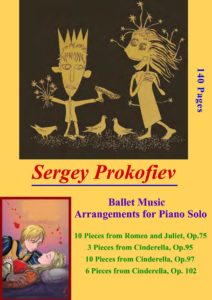Table of Contents
Prokofiev Tales of an Old Grandmother Op. 31 sheet music, Noten, partitura, spartiti, partition, 楽譜
Come join us now, and enjoy playing your beloved music and browse through great scores of every level and styles!
Can’t find the songbook you’re looking for? Please, email us at: sheetmusiclibrarypdf@gmail.com We’d like to help you!

Best Sheet Music download from our Library.

Please, subscribe to our Library.
If you are already a subscriber, please, check our NEW SCORES’ page every month for new sheet music. THANK YOU!
Browse in the Library:
Or browse in the categories menus & download the Library Catalog PDF:
Sergei Prokofiev: The Icy Firebrand of 20th-Century Music
Sergei Prokofiev (1891-1953) stands as one of the most original, prolific, and paradoxically compelling voices in 20th-century classical music. A composer who effortlessly straddled tradition and avant-garde audacity, his work crackles with a unique blend of driving energy, sardonic wit, tender lyricism, and profound emotional depth. His music is instantly recognizable – often characterized by its motoric rhythms, biting dissonances that resolve into surprising consonance, and melodies that range from fiercely angular to achingly beautiful.
From Prodigy to Provocateur:
Born in Sontsovka, Ukraine, Prokofiev displayed astonishing musical talent early on. Entering the St. Petersburg Conservatory at 13, he studied under giants like Rimsky-Korsakov and Lyadov. However, the young Prokofiev quickly gained a reputation as an enfant terrible. He rebelled against the prevailing Romanticism and Impressionism, forging his own path with works that shocked and exhilarated. Pieces like the “Scythian Suite” (a riot of primal energy) and his early piano concertos (notably the percussive and virtuosic Piano Concerto No. 2) announced a fearless modernist with a penchant for the barbaric and the brilliant.
The Prokofiev Sound: Key Characteristics:
- Motor Rhythm & Toccata Drive: Prokofiev had an unparalleled gift for propulsive, machine-like rhythms. Think of the relentless finale of his Symphony No. 7 or the exhilarating Toccata, Op. 11 for piano. This energy became a signature.
- “Wrong-Note” Modernism: He masterfully employed dissonance, often using unexpected harmonies or jarring “wrong notes” that create tension, irony, and a unique sense of color. Yet, these dissonances frequently resolve in surprisingly traditional and satisfying ways.
- Neoclassical Clarity: Especially after his period abroad, Prokofiev embraced a cleaner, more transparent texture inspired by 18th-century forms. The “Classical” Symphony (No. 1) is the quintessential example – Mozartian in structure but unmistakably Prokofiev in its spiky melodies and rhythmic quirks.
- Lyricism of Uncommon Beauty: Beneath the modernist exterior lay a deep vein of Romantic melody. His gift for soaring, long-breathed, often melancholic lines shines in works like the Violin Concerto No. 1, the ballet “Romeo and Juliet” (“Dance of the Knights” and Juliet’s Theme), and the heartbreakingly beautiful “Overture on Hebrew Themes”.
- Sarcasm and Grotesquerie: Prokofiev possessed a sharp, often sardonic wit. This manifests in biting scherzos, grotesque caricatures (like the knights in the opera “The Love for Three Oranges”), and music of pure, playful mischief (much of “Peter and the Wolf”).
Exile and Return:
The turmoil of the Russian Revolution led Prokofiev to emigrate in 1918. He spent nearly two decades abroad (mainly in the US and Paris), achieving international fame as a composer and pianist. This period saw masterpieces like the Piano Concertos No. 3 & 5, the ballets “Le Pas d’Acier” and “The Prodigal Son”, and the opera “The Fiery Angel”.
In 1936, he made the fateful decision to return permanently to the Soviet Union. While initially embraced, he soon faced the oppressive constraints of Stalinist cultural policy (Socialist Realism). His works were frequently denounced as “formalist” and inaccessible to the masses. Despite this, and the immense personal hardship during WWII, Prokofiev produced some of his most profound and popular works:
- “Peter and the Wolf” (1936): A timeless symphonic fairy tale for children, brilliantly illustrating characters with specific instruments.
- “Romeo and Juliet” (1935-36): Arguably the greatest ballet score of the 20th century, overflowing with drama, passion, unforgettable melodies, and thrilling orchestration.
- “Alexander Nevsky” (1938): A monumental film score (later a cantata) evoking Russian history with epic choral writing and visceral battle scenes.
- The “War Sonatas” (Piano Sonatas No. 6, 7 & 8): Composed during WWII, these are titanic, emotionally charged works reflecting the turmoil of the era, showcasing his most powerful and complex piano writing.
- Symphony No. 5 (1944): A grand, heroic work intended as a “hymn to free and happy Man,” balancing Soviet grandeur with deeply personal expression. Symphony No. 6 is its darker, more complex counterpart.
- “Cinderella” (1944): A ballet score of sparkling charm, rich orchestral color, and exquisite waltzes.
A Complex Legacy:
Prokofiev’s life ended tragically. He died on March 5, 1953 – the same day as Stalin – overshadowed by the dictator’s death and after years of declining health and official persecution. His final masterpiece, the ethereal Symphony No. 7, seems a poignant farewell.
Prokofiev’s genius lies in his astonishing versatility and the unique synthesis he achieved. He could be fiercely modern and reassuringly tonal, savagely rhythmic and meltingly lyrical, hilariously satirical and deeply moving – sometimes within the same piece. He absorbed Russian tradition, Western modernism, and neoclassicism, forging an utterly distinctive musical language.
His music continues to captivate audiences worldwide. Whether it’s the thrilling danger of a piano toccata, the heartbreaking sweep of a Romeo and Juliet balcony scene, the playful narration of Peter and the Wolf, or the epic grandeur of Nevsky, Prokofiev’s compositions offer an inexhaustible wellspring of invention, emotion, and sheer sonic excitement. He remains, in the best sense, a composer for all seasons and all listeners – a true giant whose music retains its power to shock, delight, and profoundly move.
